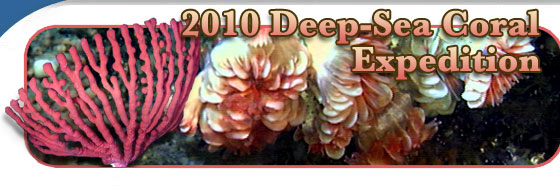Error processing SSI file
|
Blog June 27, 2010:
The Beginning of Leg 3
Dani Lipski, CINMS Research Specialist
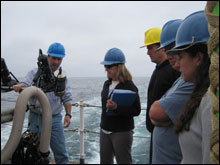 |
| ROV crew gets briefed by ROV personnel on the ROV. (Photo: NOAA) |
Leg 3 of the NOAA West Coast Deep Sea Coral cruise began Sunday June 27 2010. The science crew and all of our gear were picked up at 7am in Santa Barbara by the ship Rigid Hulled Inflatable Boat (RHIB), which was then lifted up next to the McArthur II where we could step of onto the ship It took three trips to load all of us.
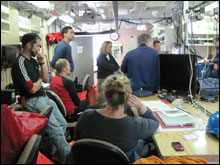 |
| The science party holds a meeting before starting operations to discuss goals of the mission, logistics, and roles. Chief Scientist Mary Yoklavich (standing, in black) is in charge of the science operations. (Photo: NOAA) |
Once on board we had a safety briefing and a science party briefing while we traveled to our working location in the Footprint Marine Reserve within the Channel Islands National Marine Sanctuary. We planned to do an ROV dive as soon as we got to the site. The weather cooperated, especially compared to the challenging weather conditions encountered on legs 1 and 2. The ROV team prepped the vehicle and it took some time for the science team to get oriented to the equipment set up. We began our first ROV dive around 2pm at the top of piggybank reef at a depth of about 300-340 meters. The habitat included some rocky boulders with lots of invertebrates, including basket stars, a variety of corals such as black corals (including the Christmas tree corals), gorgonians, and stony corals, brittle stars, and a few rockfish.
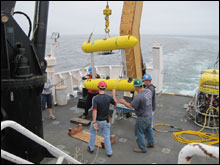 |
| The AUV crew readies the vehicle for launching later that evening. (Photo: NOAA) |
When the ROV completed the dive around 6pm, I got ready to take the water samples. The samples are collected using a piece of equipment called a rosette. The rosette contains twelve 2 liter bottles that are open at the top and bottom allowing sea water to flow through. The rosette is lowered into the water column and the certain bottles are closed at different depths capturing the water at that depth and bringing it in a sealed container to the surface. This way we can characterize the water column.
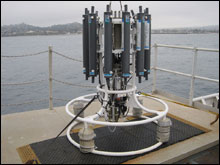 |
| The rosette that collets water samples. (Photo: NOAA) |
These samples will be sent to the University of Georgia where they will be analyzed for dissolved inorganic carbon, total carbon, pH, pCO2, and total alkalinity. We are also taking small samples that are frozen for later determination of total nutrient and isotopic signatures that will tell us about the nutrient source and flow through the ecosystem. .
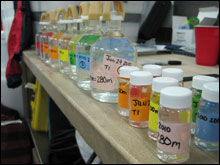 |
| Water samples successfully collected. (Photo: NOAA) |
The water samples will help characterize the physical environment of the coral habitat and will also tell us something about ocean acidification (see Corals and Chemisty essay).
|

